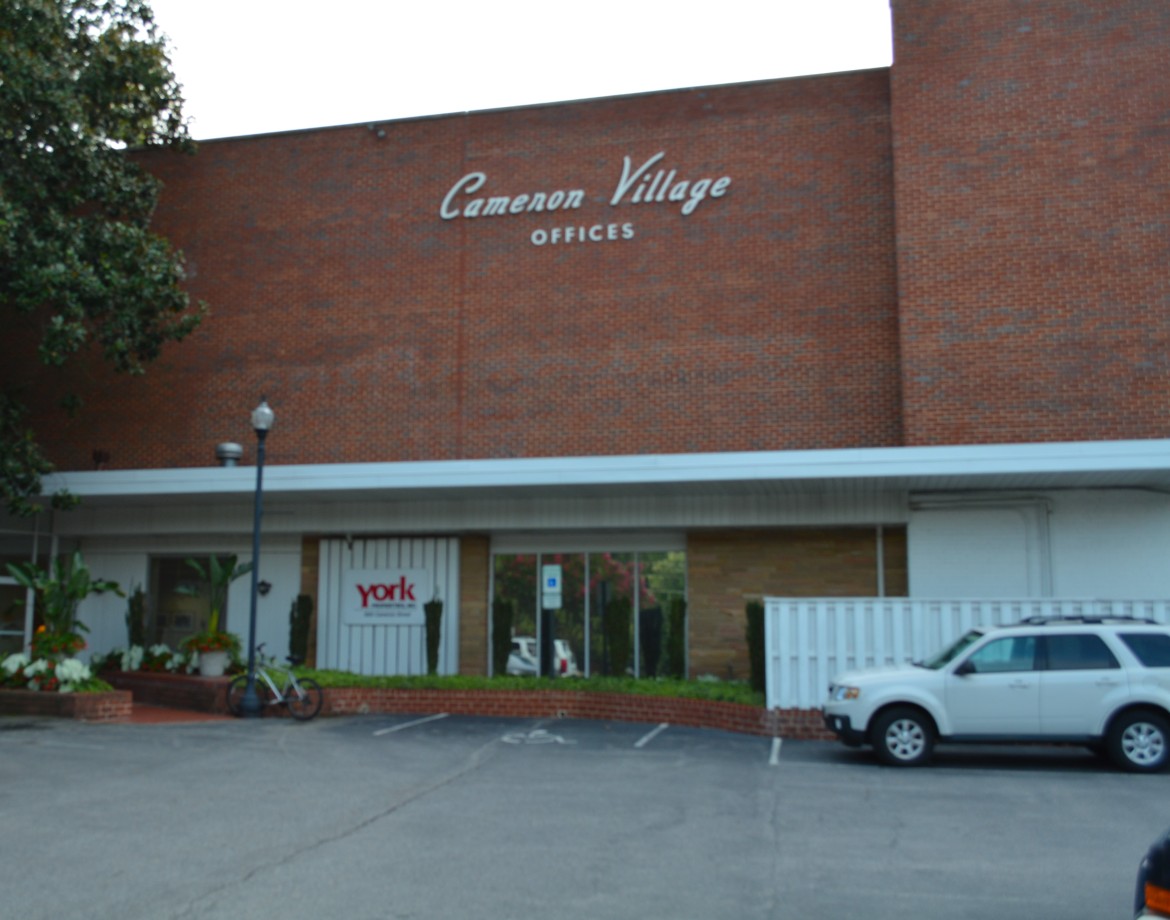As the city explores the future of the free R-Line bus, a group of merchants and residents have started a petition to have the service extended to Cameron Village.
About a dozen of these stakeholders met recently in the York Property Offices behind the Cameron Village Rite Aid.
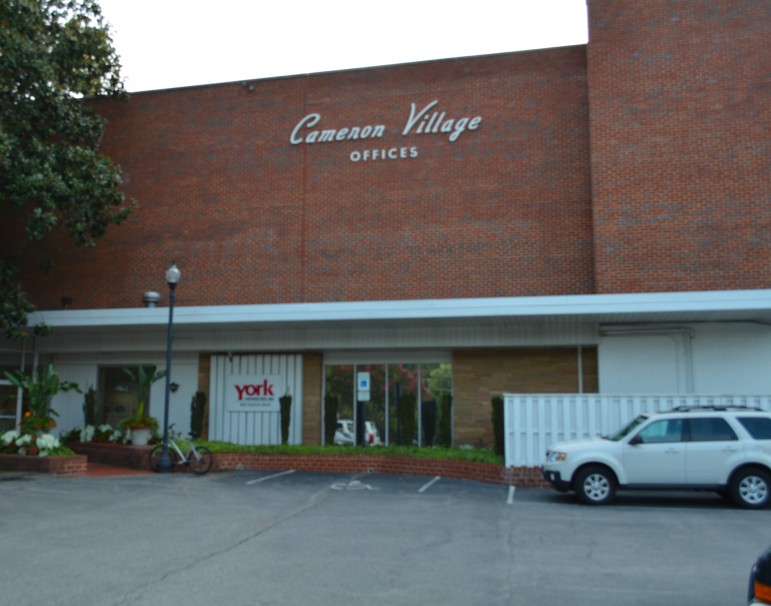
James Borden / Raleigh Public Record
The York Property offices in Cameron Village
“We started to hear some things in the R-Line weren’t working – ridership is down, it’s not serving its purpose. We thought this was a perfect time to throw our hat in the ring,” said Pat Boyle, executive director of the Cameron Village Merchants Association.
Boyle said the group began its campaign following years of requests from the general public.
A “Free” Service
With the recent announcement of the city’s plan to raise fares on the CAT buses, many within the community have decried the fact that the taxpayer-funded R-Line will remain free.
Peter Gilbert, a fellow at the UNC Center for Civil Rights, said the disparity between the clientele of the R-Line and the regular CAT buses is something the city needs to consider before making any decisions on changing its transit service.
Gilbert recently wrote an 
Gilbert said the city promotes the R-Line as a service for tourists, which he said “suggests a whiter and more affluent ridership.”
On the other hand, he said, the CAT buses are ones which riders “rely on to do their grocery shopping, go to medical appointments and get to work every day.”
“Do we really need to be subsidizing the bus fare for a line that is designed for pleasure, primarily for tourism?”
Raising the Rates
In 2013, four local transit agencies – Raleigh’s CAT system, Durham’s DATA, Cary’s C-Tran and the regional Triangle Transit service – began working on a plan to raise their rates incrementally, beginning in 2014. DATA later backed out.
In Raleigh, CAT will increase the cost of a single fare from $1 to $1.25 beginning October 1. The impending fare hike has been a contentious issue for many in the city.
Before finalizing the increase, the transit agencies were required to put together a Title VI Fare Equity Analysis Report, a requirement under the 1964 Civil Rights Act for any agencies receiving federal funding.
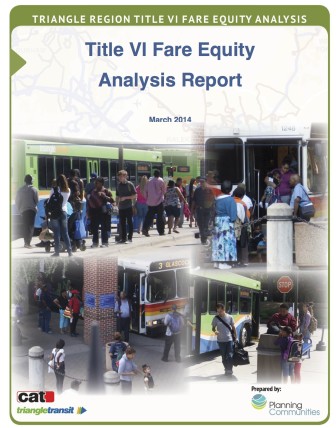
City of Raleigh
The Title VI Report is a comprehensive study of the demographics of Raleigh’s Public Transportation system
The report found that 72 percent of the CAT ridership was African-American, which is more than double the proportion of the city’s population as a whole.
Fifty-five percent of those surveyed made less than $15,000 per year.
Gilbert said the ridership of the R-Line should have been included as part of the analysis.
“They chose not to survey the R-Line, which means that all of the data they have about ridership of the lines is for the other lines that cost money,” Gilbert said.
“Their fares are going up and those lines are all supermajority African-American and an extremely low-wealth ridership for the most part.”
David Eatman, a transit administrator with the city of Raleigh, said the R-Line was not included because the survey only applied to bus lines where the fare is going to be increasing.
If the R-Line was to start charging its riders, Eatman said, “we would have to do a fare equity analysis, and if the routes changed we would have to do a service equity analysis as part of that as well.
“If we decided to make changes, these additional analyses will occur in the near future, before any actual change occurs.”
Eatman cited a recent, less comprehensive survey of the R-Line ridership, which he said included a 56 percent minority population. The survey, Eatman said, also found that 46 percent of the riders had a household income below $28,000.
Expanding the R-Line
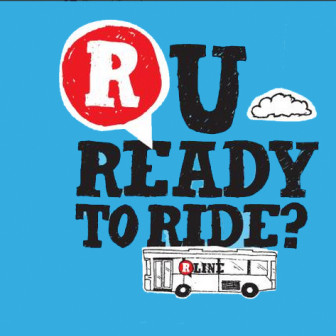
The logo for the R-Line expansion petition
Pat Boyle with Cameron Village said it was not their intent to sort out the specifics of how the city operates the R-Line and that they had no interest in getting involved with the controversy currently surrounding the line.
“The area’s incredibly congested and it’s going to become more so, and we need more opportunities to move around within the community,” she said.
Boyle said in order for the campaign to succeed, they had to be able to provide evidence of support for the idea of bringing the R-Line to Cameron Village.
“We’ve been told by the NCDOT that numbers talk,” she said.
“We went to the city council and tried to get on their petitions by citizens committee, then we had to go back to the Department of Transportation,” Boyle said.
“We’re never going to get any further traction unless we increase our numbers.”
The petitions – and signage promoting them – are visible in most Cameron Village shops.
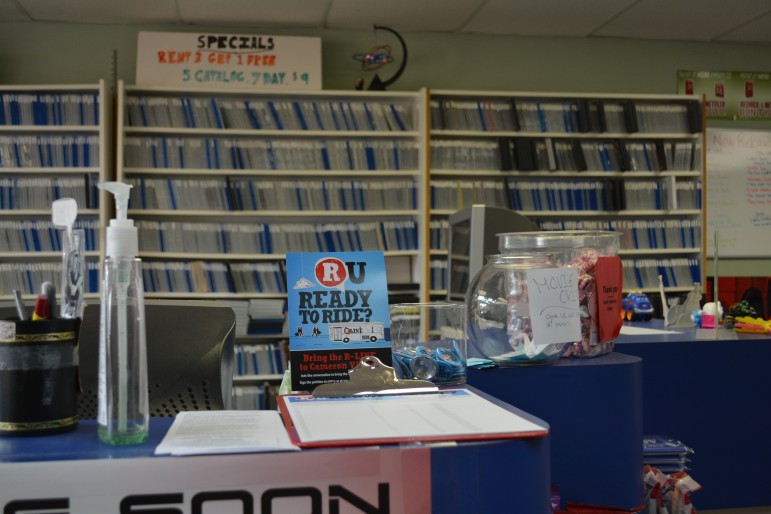
James Borden / Raleigh Public Record
A petition to extend the R-Line’s service to Cameron Village at North American Video has received dozens of signatures
Sara Walker, who also works for the CV merchants’ association, said Chick-Fil-A had already gone through three pages of signatures.
R-Line Necessity
Jeff Murison, executive director of the Hillsborough Street Business Improvement District, was also in attendance at the Cameron Village meeting. He questioned the current popularity of the free bus system, which has seen a recent decline in ridership.
“Everybody thinks the R-Line is awesome, but there’s not a lot of evidence to support that,” he said.
Murison said he heard reports that some women find the bus’s darkened windows – which make riders unable to see who is inside without boarding – somewhat menacing due to the lack of visibility.
Although Murison said his organization has also fielded requests for getting the R-Line extended out their way, he wasn’t sure whether it would provide much of a benefit.
“Somebody told me Hillsborough Street has more routes and stops than anywhere in the city – if that’s the case, why do we need another one?” Murison said.
Current Accessibility
As with Hillsborough Street, Cameron Village is already accessible through the existing CAT system. Buses running to and from Cameron Village every 15 minutes during peak hours Monday through Friday, and every half hour on Saturdays.
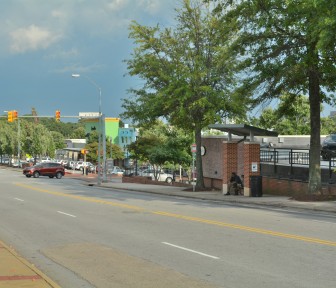
James Borden / Raleigh Public Record
An existing CAT stop near the Cameron Village Harris Teeter
On Sundays, there is one bus per hour.
The R-Line runs every 15 minutes on its existing route, although on Sunday it only runs from 1-8 p.m.
One of the reasons Cameron Village needs increased transit access, Boyle said, is that its Fresh Market and Harris Teeter are the two closest grocery stores to downtown.
The area is also about to gain dozens of new apartments, whose residents will likely want quick and easy access to downtown Raleigh’s bars and restaurants.
It was noted that many of those targeted by the R-Line’s service are not the same among the crowd that rides the regular CAT buses, which was why bringing the R-Line to Cameron Village would have a significant impact on traffic density.
Raleigh’s Transit Future
Gilbert said however the city designs its bus systems, “they ought to be designed in such a way that serves the people who depend on it and who need it the most – which in Raleigh are low-wealth riders and the African-American community.”
Eatman could not comment on any specific plans for the future except to say that more studies will have to be done first.
